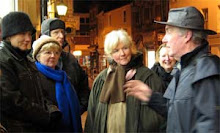Friday, 9 August 2013
Tintern Abbey Monmouthshire
Tintern Abbey stands beside the River Wye, just off the A466, five miles north of Chepstow. The abbey is the best preserved and the first of its kind in Wales. Its seclusion in a wooded valley was much favoured by the twelfth-century order of the Cistercian 'white monks' (white, because of their undyed habits) of Citeaux near Dijon in Burgundy, who built the first abbey. Its remoteness suited their order of simplicity, seclusion, austerity and manual labour. Its close proximity to the River Wye was favoured for its convenience as it allowed ships to deliver supplies. The first abbey was founded in 1131 on lands given to the Cistercians by Walter fitz Richard de Clare, the Lord of Chepstow. Little remains of the first abbey buildings which were in a traditional cruciform style. In 1270 the fifth Earl of Norfolk - Roger Bigod was consecrated Abbot of Tintern and set about a mammoth rebuilding project which would take thirty-two years to complete.
The ruins have inspired many poets and artists over the centuries. One of the most noted artists was J.M.W. Turner, a British painter famous for his watercolour landscapes. Turner painted several pictures of the abbey during the late 1700s.
The abbey was surrendered to King Henry VIII on 3rd September 1536, which ended the monastic occupation of over 400 years. The site was granted to Henry - Earl of Worcester, who bought the lead and bells from the Crown, probably to use in his castles at Chepstow and Raglan. This ‘plundering’ left the abbey roofless and as a consequence it slipped into decline. It was rescued in 1901 when it was bought by the Crown before being passed on in 1914 to the then Office of Works, now known as Cadw: Welsh Historic Monuments who set about rescuing the abbey from further decline.
When the Black Death hit Britain many of the monks at Tintern were amongst those who perished. It may be these same monks who have been seen walking toward the abbey in single file with flaming torches.
There is a legend that the devil used to sit outside the abbey on a stony outcrop where he would endeavour to entice the monks away from Christianity with promises of great wealth.
Another legend tells of a group of young men, possibly in the 1700 or 1800s who decided to dig within the abbey grounds looking for antiquities but instead found the skeletons of two individuals who they assumed must be the remains of two of the white monks. To celebrate their finds they feasted inside the abbey ruins alongside their trophies. That evening they laughed and joked at what the dead monks of Tintern would have thought of their disrespectful revelry. At that moment the skies darkened and a storm threatened, thunder and lightening lit up the surrounding valley. This sudden unexpected change in the weather unnerved the men but worse was to come, for out of the mist which had descended on the abbey as suddenly as the storm, came a shimmering light which seemed to dance off something metallic. As the men anxiously sort the source of the light there appeared at the choir the image of a male knight in chain armour, his helmet visor raised. If this wasn’t bad enough, immediately behind him walked many hooded monks. The terrified men stood frozen to the spot as the ghostly procession advanced. Each man deeply regretting disturbing the rest and peace of the Cistercian monks of Tintern Abbey. The procession stopped and the knight fixed the men with a penetrating stare. Slowly he raised his gauntleted hand and pointed with his sword to the doorway. At this prompt the men fled in terror, behind them they witnessed a whirlwind which passed through the abbey picking up the remains of their feast which followed them out of the abbey ruins and in so doing restored respect for the dead.
Our day out at Tintern Abbey included a celebration with friends of my partners birthday. She asked me to take her somewhere quiet, peaceful and tranquil. Tintern ticked all those boxes. Strolling through these beautiful ruins was an awesome experience and one can clearly see why it has inspired artists and poets for centuries.
Subscribe to:
Post Comments (Atom)







3 comments:
I went to Tintern Abbey, it's a lovely place. I didn't feel a presence or anything at all. Far more creepy is Chepstow castle near Tintern Abbey, the feeling of being watched there, especially in the dungeon, was almost unbearable.
Hello 'anonymous, ' Chepstow is on my list of places to visit, it's just finding time. I am currently working on my second book so time is at a premium.
Hi anonymous, when you say "dungeon", where do you mean? I recently went to Chepstow Castle. There's the wine cellar down below and the small circular prison near the castle shop. I felt so horrible while in that prison room, I couldn't go back in.
Post a Comment